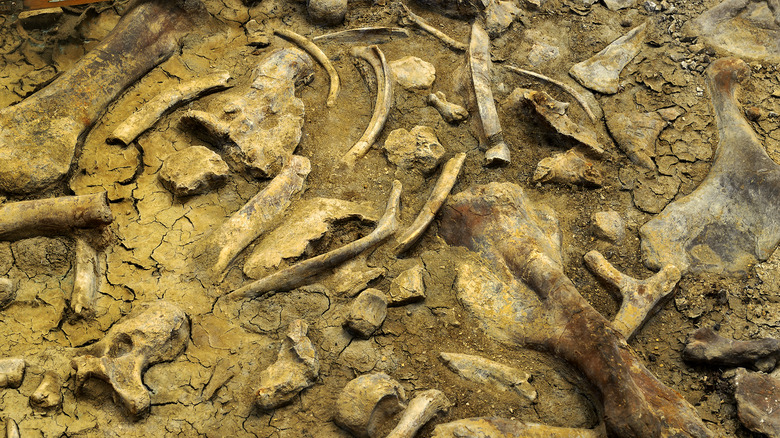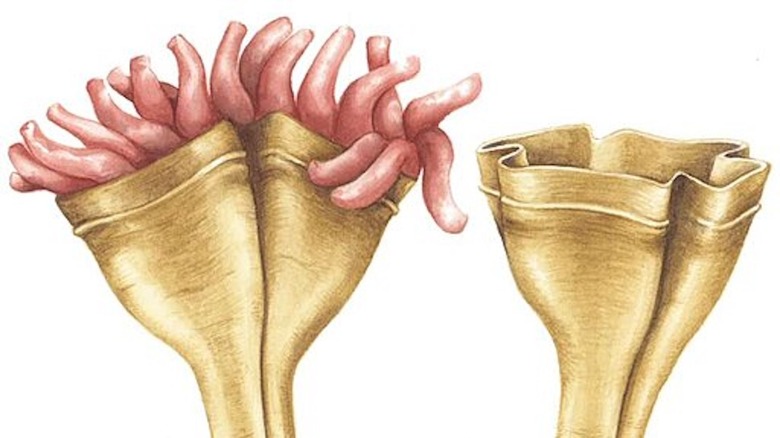A United Kingdom Fossil May Be Earth's First Animal Predator
Ancient fossils can reveal a lot about what Earth may have looked like before humans came into existence. Studying these fossils can help us learn about our own ancestors and how we formed from them. One such fossil is that of a strange creature with tentacles thought to have lived in the deep ocean over 560 million years ago (via Live Science). This fossil was studied as part of a research paper published recently that examined a specimen found over a decade ago.
The specimen in question is that of Auroralumina attenboroughii, a sea creature that was newly identified in the study. The paper, published in Nature Ecology & Evolution, outlined several new findings about the creature by studying one of its fossils, which was found in 2007 in the Charnwood Forest in the U.K. Auroralumina attenboroughii is ancient, dating back to before the Cambrian explosion, a time period approximately 530 million years ago in which the fossil record exploded with new life forms (via Britannica).
Auroralumina attenboroughii may be the first known predator
One of the most interesting discoveries the researchers behind this study found was that Auroralumina attenboroughii may be the first known predator in the animal kingdom. It dates back to a period known as the Ediacaran, which took place before the Precambrian and Cambrian periods. According to ScienceDirect, most fossils found from this period were from soft-bodied organisms. According to Philip Donoghue, a professor of palaeobiology at the University of Bristol in England (via Live Science), "It's almost unheard of for Precambrian fossils to resemble forms seen in animals alive today, so the discovery of an Ediacaran animal resembling a jellyfish is exceptional."
According to Dr. Frankie Dunn, lead author of the paper describing the fossil, Auroralumina attenboroughii is unlike anything else on the fossil record from the Ediacaran period. "[It] clearly has a skeleton with densely packed tentacles that would have waved around in the water capturing passing food, much like corals and sea anemones do today," he said, per the Natural History Museum. This indicates the possibility that this previously unknown creature may be one of the oldest predators we have found so far.
Researchers named Auroralumina attenboroughii after biologist Sir David Attenborough
Researchers behind the paper studying the fossil of Auroralumina attenboroughii carefully chose its name. Its genus, Auroralumina, is a Latin name meaning "dawn lantern." According to Live Science, this is a reference to how early of a time period the creature comes from and the fossil's lantern-like shape. The species name "attenboroughii" was chosen after biologist Sir David Attenborough. According to the paper, the team named it after him for "his work raising awareness of the Ediacaran fossils of Charnwood Forest," where the fossil was first discovered (via Nature Ecology & Evolution).
This fossil may be the stepping stone between modern jellyfish and early ocean life forms. According to the National History Museum, Auroralumina attenboroughii may be a stepping stone between the Ediacaran and Cambrian time periods, as it has a shape more similar to fossils found from the Cambrian era. As lead researcher Dr. Frankie Dunn puts it (via Phys.org), "Our discovery shows that the body plan of the cnidarians [corals; jellyfish; sea anemones, etc.] was fixed at least 20 million years before this, so it's hugely exciting and raises many more questions."


